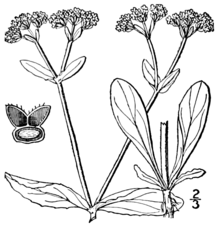Valerianella umbilicata
| Valerianella umbilicata | |
|---|---|

| |
| Scientific classification | |
| Kingdom: | Plantae |
| Clade: | Tracheophytes |
| Clade: | Angiosperms |
| Clade: | Eudicots |
| Clade: | Asterids |
| Order: | Dipsacales |
| Family: | Caprifoliaceae |
| Genus: | Valeriana |
| Species: | V. umbilicata
|
| Binomial name | |
| Valeriana umbilicata (Sullivant) Christenh. & Byng
| |
| Synonyms[1] | |
| |
Valerianella umbilicata, is a synonym for Valeriana umbilicata known by the common name navel cornsalad.[1] It is a dicot, annual plant in the flowering plant family Caprifoliaceae. It is native to the Eastern North America and some parts of Canada and has no known uses other than being edible.[2]
Description
Navel cornsalad is an herbaceous succulent annual plant.[3] It has dichotomously branched leaves that are attached along the stem rather than attached at the base. The leaves are spatulate, or "spoon-like" and are attached directly to the stem without a petiole. [3] It can be anywhere between 3-6 dm tall. The petals are either white or pink to red,[4] and range from 2-5 mm long. The pollen bearing organs project out strongly. They are rare and found in fields, roadsides, and waste places.[3]
Distribution and habitat
Valerianella umbilicata is native to CAN N and L48 N (lower 48 states)[2] and has a known distribution that includes specimens from the central Piedmont to the southern Mountains. This species appears to be absent from the northern mountains and the Piedmont foothills.[5] V. umbilicata is rare and lives in damp and open environments. It thrives in disturbed areas such as damp meadows, bottomland openings, roadsides,[5] marshes, and fields.[4]
Human disturbances such as development, deforestation, and changes must be avoided by the Valerianella umbilicata species. This species has minimal comprehensive habitat information.[6]
Uses
This species of cornsalad is not known to be used by wildlife and has no known medical uses,[7] but it can be eaten as a vegetable.[8]
Conservation status
The global ranking on conservation status is G4-G5.[6][9] There is no US status,[6] however individual states have included a state rank. In Michigan, V. umbilicata is threatened (T) and legally protected by the state and holds a state rank of S2 - Imperiled.[6] North Carolina's state rank is SH - Endangered.[10] New Jersey's state rank is SH - Endangered.[2]
References
- ^ a b "Valeriana umbilicata (Sull.)Alph.Wood". Plants of the World Online. Royal Botanic Gardens, Kew. Retrieved 14 April 2024.
- ^ a b c "USDA Plants Database". plants.usda.gov. Retrieved 2022-04-13.
- ^ OCLC 355003.
- ^ a b "Valerianella umbilicata (navel corn-salad): Go Botany". gobotany.nativeplanttrust.org. Retrieved 2022-04-13.
- ^ a b "Vascular Plants of North Carolina". auth1.dpr.ncparks.gov. Retrieved 2022-04-13.
- ^ a b c d "Valerianella umbilicata (Corn salad) - Michigan Natural Features Inventory". mnfi.anr.msu.edu. Retrieved 2022-04-13.
- ISBN 9781315118116, retrieved 2022-04-14
- )
- ^ "NatureServe Explorer 2.0". explorer.natureserve.org. Retrieved 2022-04-18.
- ^ "Vascular Plants of North Carolina". auth1.dpr.ncparks.gov. Retrieved 2022-04-14.

